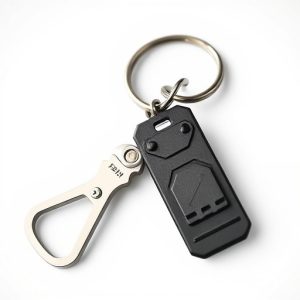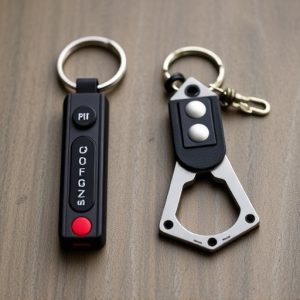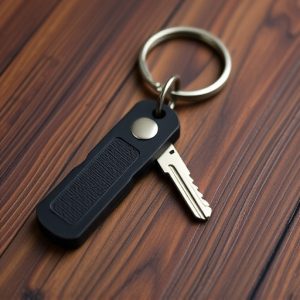Mastering Metal Keychain Grip Design for Pressure Point Defense
Mastering keychain pressure point defense moves is vital for effective self-defense using a metal ke…….
Mastering keychain pressure point defense moves is vital for effective self-defense using a metal keychain. Regular training ensures users can target critical areas like the carotid artery or eyes to incapacitate attackers quickly. Choosing the right material, such as high-quality stainless steel or titanium, depends on intended use and advanced techniques. Ergonomic hand grips should offer comfort and control, accommodating various hand sizes with contoured surfaces and textures. Strategically placing pressure points on an opponent's wrist or forearm can disable them, and testing is crucial to refine the design for durability and intuitiveness.
Unleash the power of self-defense with a custom metal keychain! This ultimate guide reveals essential design tips for creating an effective keychain grip, focusing on leveraging keychain pressure point defense moves. From selecting robust metals to crafting ergonomic hand grips, learn how to incorporate powerful pressure points for maximum protection. Discover the art of refining your design through rigorous testing, ensuring your keychain is not just a stylish accessory but a reliable tool for self-defense.
- Understanding Keychain Pressure Point Defense Moves
- Choosing the Right Metal for Your Keychain Grip
- Designing Ergonomic Hand Grips
- Incorporating Pressure Points for Maximum Defense
- Testing and Refining Your Keychain Defense Design
Understanding Keychain Pressure Point Defense Moves
Mastering keychain pressure point defense moves is key to effectively using a metal defense keychain as a self-defense tool. These moves leverage specific pressure points on an attacker’s body, allowing users to disable or temporarily incapacitate them with minimal effort and no visible injuries. Understanding where these pressure points are located and how to apply the right amount of force is crucial. For instance, targeting the carotid artery in the neck can cause loss of consciousness within seconds, while applying pressure to the eyes or throat can create enough discomfort to break free from a grip.
Knowing when and how to deploy these moves is equally important. Practicing with a trained professional or through self-defense courses can help users develop the necessary sensitivity and precision. Regular training ensures that when faced with an actual threat, individuals remember the techniques and execute them effectively under stress. By combining these pressure point defense moves with proper grip techniques for the keychain, users can maximize their chances of escaping unsafe situations safely.
Choosing the Right Metal for Your Keychain Grip
When designing a metal defense keychain grip, selecting the appropriate material is a pivotal step. The ideal metal should balance durability and versatility for various keychain pressure point defense moves. High-quality stainless steel is often a favorite choice due to its resistance to corrosion and ability to maintain a sharp edge, essential for effective self-defense techniques. However, for those seeking a lighter option, titanium could be the answer, offering exceptional strength-to-weight ratio without sacrificing durability.
Consider the intended use when making your decision. If the keychain is primarily for everyday carry and light self-defense, standard metals like 304 stainless steel might suffice. Yet, if you’re creating a specialized tool for advanced pressure point techniques, investing in more robust metals such as 410 stainless steel or titanium can ensure the keychain stands up to rigorous training and real-world applications.
Designing Ergonomic Hand Grips
When designing ergonomic hand grips for a defense keychain, it’s crucial to focus on comfort and control. Consider the shape and size of hands that will be using it—a grip shouldn’t be too tight or loose, allowing for a natural and secure hold. Incorporate ergonomic principles like contoured surfaces that mimic the palm’s curve, providing stability and reducing strain during keychain pressure point defense moves.
The key is to balance functionality with comfort. Well-placed textures or ridges can enhance grip without causing discomfort, enabling swift and precise movements. Remember, the goal is to ensure users can easily manipulate the keychain during stressful situations, making it an effective tool for self-defense while feeling comfortable in their hands.
Incorporating Pressure Points for Maximum Defense
Incorporating pressure points into your keychain grip design can significantly enhance its defensive capabilities. Pressure point defense moves leverage specific areas on the human body that, when targeted, can disable or immobilize an attacker temporarily. By strategically placing a pressure point on the opponent’s wrist, forearm, or even the base of their thumb, you can disrupt their grip and gain control of the situation. This tactic is particularly useful in self-defense scenarios where speed and precision are crucial.
When designing your keychain, consider incorporating a mechanism that allows for quick access to these pressure points. This might include a pivoting arm or a retractable trigger that activates when pressed, enabling you to deploy the pressure point defense move with minimal effort and maximum effectiveness. Remember, the key is to strike quickly and accurately, using the force of your body and the keychain’s design to turn an attacker’s strength against them.
Testing and Refining Your Keychain Defense Design
When refining your metal keychain defense design, testing is paramount. It’s crucial to assess each component and how they interact under various conditions. Apply pressure at different points on the keychain to observe its flexibility and durability. This can help you identify potential weak spots and refine your design to mitigate them. For instance, focus on the joint areas where components connect; these are common pressure points in defense moves.
During testing, consider how users will interact with the keychain. Practice various gripping techniques and movements to ensure the design allows for smooth, secure operations. Remember, a well-designed keychain should be intuitive, allowing users to execute defense moves swiftly and effectively. Refine based on feedback from multiple testers to create a robust, reliable pressure point defense mechanism.
Creating an effective metal defense keychain involves a blend of understanding pressure point defense moves, selecting suitable metals, designing ergonomic grips, strategically incorporating pressure points, and rigorous testing. By combining these essential elements, you can craft a compact yet powerful self-defense tool. Remember, the key to success lies in refining your design through continuous testing and user feedback, ensuring it delivers when it matters most. Implement these tips, and your keychain will be more than just a convenience—it could save lives.


